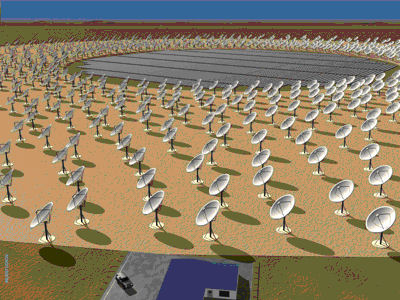Netherlands Institute for Radio Astronomy (ASTRON)
Dwingeloo, 9 december 2008
SKA Identified as an Essential Facility for the Future of European Astronomy
Europe's 20 year plan for astronomy was unveiled on 25 November 2008 by the ASTRONET consortium at the Academy of Sciences, Paris, France.
The Square Kilometre Array (SKA) - comprising thousands of antennas giving a total collecting area approaching a million square metres - has been ranked joint top priority by the ASTRONET consortium of European funding agencies as they unveiled Europe's 20 year plan for astronomy on 25 November 2008 at the Academy of Sciences, Paris, France.
ASTRONET, created to establish a long-term plan for the development of European astronomy, has published a European Infrastructure Roadmap for Astronomy. This builds upon the European astronomy community's Science Vision, published in 2007. The Infrastructure Roadmap sets out a comprehensive plan for European astronomy over the next two decades and identifies the large research facilities needed to attain Europe's scientific goals. Over 60 selected experts from across Europe contributed to the European Infrastructure Roadmap.
Professor Thijs van der Hulst, Chair of the European SKA Consortium, a collaboration of thirteen research institutes and consortia throughout Europe, expressed delight at the SKA's priority ranking in the ASTRONET Roadmap, "the development of new technologies in radio astronomy in Europe has prepared the road for the SKA and it is really rewarding to see the recognition of this unique facility as a top priority for the next decade".
Richard Schilizzi, Director of the SKA Program Development Office (SPDO) also welcomed the top ranking of the Square Kilometre Array and stated that "the SKA is a global initiative and this endorsement by the European astronomy community means that Europe will remain in the forefront of radio astronomy for many years to come".
First science observations are expected to begin in 2016 when about one fifth of the instrument has been put in place. When completed in 2021, the SKA will give astronomers an instrument with unprecedented sensitivity with which to observe the universe and will be capable of answering some of its most fundamental questions. It will be able to study how the stars and galaxies were formed in the early universe and help us understand the nature of the mysterious "Dark Energy" which now appears to be making the universe expand at an ever faster rate.
The SKA will also be a unique tool for testing the laws of physics in extreme conditions, in particular in the strong gravity fields of pulsars and black holes, so testing Einstein's theories to the limit. By using the SKA as an instrument for detecting gravitational waves we may be able to probe the universe as it was shortly after its creation in the Big Bang, at a time before light and radio waves were able to travel through the universe. In addition, it is expected that, over a many decade lifetime, the SKA will discover aspects of the universe about which we have currently no knowledge.
Building on the combined experience of LOFAR and APERTIF, which explore new technologies for SKA, the ongoing ASTRON-led European research program SKADS, and e-VLBI pioneered at JIVE under an EC sponsored programme EXPreS, the Netherlands is well positioned for a major role in the SKA. Dutch astronomers were assembled at the NWO Institute ASTRON last week to discuss their role in SKA science and technology and their engagement into SKA in a two-day workshop.
Notes for editors

Artist's impression of the central region of the Square Kilometre Array. At its heart lies a phased array capable of observing the whole sky and able to provide multiple beams so that several tasks can be carried out simultaneously. Surrounding this is the compact array of small dishes within a larger, more open, array. Credit: Xilos Studios
More images and animations are available on the SKA website (www.skatelescope.org).
SKA facts
Detailed design activities are already underway, as part of the Preparatory Study (PrepSKA) project. PrepSKA is a global endeavour involving funding agencies and scientists working which is also exploring the appropriate legal, policy and technical framework required for the SKA. It is a three year €22M project (€5.5 M from the European Community Framework Programme 7 funds), which commenced on 1 April 2008. It is expected that further funding will be provided by the EC to enable detailed design work to be completed.
Building work is due to start in 2013, subject to successful funding proposals. The SKA will be constructed in a phased manner over a seven year period. Operations should start in 2016 once a significant portion of the array has been commissioned. The array will be constructed of several thousand antennas spread with a total collecting area of a square kilometre. The antennas will be distributed in approximately 200 'stations' spread over roughly 3000 km. The location of the array is still to be decided, with Australia and South Africa both on the short-list.
Contacts
Professor Ian Morison
SKA Outreach Officer
Email: morison@skatelescope.org
Tel: + 44 (0)161 275 4162
Professor Thijs van der Hulst
Chair
European SKA Consortium
Email: j.m.van.der.hulst@rug.nl
Tel: +31 (0)50 363 4054
Professor Arnold van Ardenne
SKADS Coordinator
Email: ardenne@astron.nl
Tel: +31 (0)521595144
